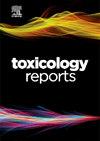发酵和未发酵无花果酸乳杆菌汁对大鼠镉毒性的缓解作用
Q1 Environmental Science
引用次数: 0
摘要
刺梨含有天然化合物,具有抗炎、抗氧化和神经保护作用。本研究评价了正常(NCJ)和乳酸杆菌发酵的仙人掌汁(FCJ)对雄性白化大鼠镉毒性的降低作用。对两种果汁的理化性质进行了分析,结果表明,发酵增加了总酚类物质和类黄酮,提高了48.61% %的抗氧化活性,延长了60天的保质期。为了评价镉的解毒作用,将大鼠分为6组:G1组(生理盐水对照组)、G2组(镉中毒组)、G3和G5组(仅NCJ和FCJ组)、G4和G6组(镉暴露联合NCJ或FCJ组)。60 d后,通过检测基因表达(TNF-α、P53、BCL-2、IL-1)和组织组织学检查来评估镉的有害影响。两种果汁都降低了镉毒性标志物,其中FCJ效果更佳。此外,果汁处理对大鼠是安全的,G3组和G5组没有观察到不良反应。这些发现表明,乳酸杆菌发酵的汁液可能有效地减少镉污染,促进生物系统的解毒。本文章由计算机程序翻译,如有差异,请以英文原文为准。
Cadmium toxicity alleviation in rats using lactobacillus-fermented and unfermented opuntia ficus-indica L. juices
Opuntia ficus-indica L. (prickly pear) contains natural compounds with known anti-inflammatory, antioxidant, and neuroprotective effects. This study assessed the ability of normal (NCJ) and Lactobacillus-fermented prickly pear juice (FCJ) to reduce cadmium toxicity in male albino rats. Physical and chemical properties of both juices were analyzed, revealing that fermentation increased total phenolics and flavonoids, boosting antioxidant activity by 48.61 % and extending shelf life by 60 days.To evaluate cadmium detoxification, rats were divided into six groups: Group G1 (saline control), Group G2 (cadmium-intoxicated), Groups G3 and G5 (NCJ and FCJ only), and Groups G4 and G6 (cadmium exposure combined with NCJ or FCJ). After 60 days, the harmful effects of cadmium were assessed by measuring gene expression (TNF-α, P53, BCL-2, IL-1) and examining tissue histology. Both juices reduced cadmium toxicity markers, with FCJ showing superior efficacy. Furthermore, the juice treatments were safe for the rats, as no adverse effects were observed in Groups G3 and G5. These findings suggest that Lactobacillus-fermented juices may be effective in reducing cadmium contamination and promoting detoxification in biological systems.
求助全文
通过发布文献求助,成功后即可免费获取论文全文。
去求助
来源期刊

Toxicology Reports
Environmental Science-Health, Toxicology and Mutagenesis
CiteScore
7.60
自引率
0.00%
发文量
228
审稿时长
11 weeks
 求助内容:
求助内容: 应助结果提醒方式:
应助结果提醒方式:


